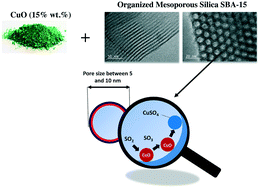当前位置:
X-MOL 学术
›
Catal. Sci. Technol.
›
论文详情
Our official English website, www.x-mol.net, welcomes your feedback! (Note: you will need to create a separate account there.)
Structure-performance relationship in CuO/SBA-15-type SOx adsorbent: evolution of copper-based species under different regenerative treatments
Catalysis Science & Technology ( IF 5 ) Pub Date : 2017-07-24 00:00:00 , DOI: 10.1039/c7cy01010a M. Berger 1, 2, 3, 4, 5 , P. Fioux 3, 5, 6, 7, 8 , S. Dorge 1, 2, 3, 4 , H. Nouali 3, 5, 6, 7, 8 , D. Habermacher 1, 2, 3, 4 , E. Fiani 4, 9, 10 , M. Vierling 4, 11, 12 , M. Moliere 4, 13, 14, 15, 16 , J. F. Brilhac 1, 2, 3, 4 , J. Patarin 3, 5, 6, 7, 8
Catalysis Science & Technology ( IF 5 ) Pub Date : 2017-07-24 00:00:00 , DOI: 10.1039/c7cy01010a M. Berger 1, 2, 3, 4, 5 , P. Fioux 3, 5, 6, 7, 8 , S. Dorge 1, 2, 3, 4 , H. Nouali 3, 5, 6, 7, 8 , D. Habermacher 1, 2, 3, 4 , E. Fiani 4, 9, 10 , M. Vierling 4, 11, 12 , M. Moliere 4, 13, 14, 15, 16 , J. F. Brilhac 1, 2, 3, 4 , J. Patarin 3, 5, 6, 7, 8
Affiliation

|
Sulphur oxides (SOx) represent a major air pollutant and are controlled by national and international regulations. CuO/SiO2 materials are known as SOx trap materials. However, their large-scale development is still hampered by the sintering of the active phase over multiple adsorption/regeneration cycles, leading to the progressive decrease in SOx adsorption capacities of the adsorbent. In this work, SBA-15 organised mesoporous silica was functionalized with highly dispersed Cu2+-based species. The as-obtained adsorbent was then assessed as a regenerable SOx trap material. An extended characterisation was performed along with adsorption/regeneration cycles to correlate the evolution of the copper species with the performance of the adsorbent under different regenerative treatments. Thermal regeneration at 600 °C under pure N2 leads to the formation of Cu+-based species, enabling a significant increase in SOx chemisorption efficiency, which nevertheless decreases during the subsequent cycles due to progressive sintering of the active phase, leading to bulky copper(II) oxide particles. Regeneration under reductive conditions (0.5 vol% of H2 in N2) was then investigated as a way to decrease the regeneration temperature and limit this sintering process. It was found that the general behaviour of the copper-based species was very sensitive to the regeneration temperature. At 600 °C, the active phase was completely converted into large metallic copper particles, giving rise to a fast decrease in SOx adsorption capacity of the adsorbent due to partial obstruction of the SBA-15 silica porosity. Conversely, when this regeneration was performed at 280 °C, no decrease in performances was noticed, and the copper species remained as a highly dispersed phase on the silica support.
中文翻译:

CuO / SBA-15型SO x吸附剂的结构性能关系:不同再生处理下铜基物种的演化
硫氧化物(SO x)代表主要的空气污染物,受到国家和国际法规的控制。CuO / SiO 2材料被称为SO x捕集材料。然而,在多个吸附/再生循环中,活性相的烧结仍然阻碍了它们的大规模开发,导致吸附剂的SO x吸附能力逐渐降低。在这项工作中,SBA-15组织的介孔二氧化硅被高度分散的基于Cu 2+的物质官能化。然后将获得的吸附剂评估为可再生的SO x捕获材料。进行了扩展的表征以及吸附/再生循环,以将铜种类的演变与不同再生处理下吸附剂的性能相关联。在纯N 2下于600°C的温度下进行热再生会导致形成基于Cu +的物质,从而使SO x的化学吸附效率显着提高,但由于活性相的逐步烧结,其在随后的循环中仍会降低,从而导致体积增大氧化铜(II)颗粒。在还原条件下的再生(h的0.5体积%的2的N 2然后研究)作为降低再生温度并限制该烧结过程的一种方法。发现铜基物质的一般行为对再生温度非常敏感。在600℃下,将活性相完全转变成较大的金属铜粒子,从而产生了在SO快速降低X的吸附剂的吸附能力由于SBA-15二氧化硅孔隙率的部分阻塞。相反,当在280℃下进行该再生时,没有观察到性能降低,并且铜物质以高度分散相的形式保留在二氧化硅载体上。
更新日期:2017-09-19
中文翻译:

CuO / SBA-15型SO x吸附剂的结构性能关系:不同再生处理下铜基物种的演化
硫氧化物(SO x)代表主要的空气污染物,受到国家和国际法规的控制。CuO / SiO 2材料被称为SO x捕集材料。然而,在多个吸附/再生循环中,活性相的烧结仍然阻碍了它们的大规模开发,导致吸附剂的SO x吸附能力逐渐降低。在这项工作中,SBA-15组织的介孔二氧化硅被高度分散的基于Cu 2+的物质官能化。然后将获得的吸附剂评估为可再生的SO x捕获材料。进行了扩展的表征以及吸附/再生循环,以将铜种类的演变与不同再生处理下吸附剂的性能相关联。在纯N 2下于600°C的温度下进行热再生会导致形成基于Cu +的物质,从而使SO x的化学吸附效率显着提高,但由于活性相的逐步烧结,其在随后的循环中仍会降低,从而导致体积增大氧化铜(II)颗粒。在还原条件下的再生(h的0.5体积%的2的N 2然后研究)作为降低再生温度并限制该烧结过程的一种方法。发现铜基物质的一般行为对再生温度非常敏感。在600℃下,将活性相完全转变成较大的金属铜粒子,从而产生了在SO快速降低X的吸附剂的吸附能力由于SBA-15二氧化硅孔隙率的部分阻塞。相反,当在280℃下进行该再生时,没有观察到性能降低,并且铜物质以高度分散相的形式保留在二氧化硅载体上。



























 京公网安备 11010802027423号
京公网安备 11010802027423号